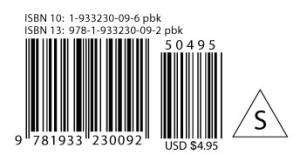Podcast: Play in new window | Download
Subscribe: Apple Podcasts | Spotify | Pandora | RSS | More
Updated January 2, 2023
Subtitle
Understanding the terminology of the book publishing industry can help us become better and more successful at self-publishing
Synopsis
Understanding the terminology, jargon, terms of art, vocabulary, and slang, of the book publishing industry can only help us become better and more successful at self-publishing. Here is a discussion of the terms “strippable” and “non-strippable” as they relate to printed books and their covers.

What You Will Learn
1. You will learn the physical differences between a book considered strippable and one not.
2. You will learn why a particular book is considered strippable.
3. You will learn who is affected by these designations.

Introduction
Most of us involved with self-publishing will never need to deal with books that are strippable or not. But, despite that fact, we still need to understand the book industry. Understanding the terminology, jargon, terms of art, vocabulary, and slang, of the book publishing industry, can only help us become better and more successful at self-publishing.
Here is a discussion of the terms “strippable” and “non-strippable” as they relate to printed books and their covers:
Strippable Defined
“Strippable” means that a book’s cover can be torn off, or stripped off, by the book retailer or distributor and then sent back to the book publisher for a credit or refund. The publisher tells the book retailers and distributors which books it will allow being stripped and which cannot.
Each publisher has rules and guidelines about which books can be stripped. Stripping off the cover of a book and sending the cover back to the publisher without the body of the book will significantly reduce postage costs.
It’s much less costly to send back a bunch of book covers than an entire box of books. The bookseller then destroys the book once the cover is stripped off.

Title page of a mass-market paperback book. The paragraph in the middle discusses the cover and what happens when a book is stripped.
Non-strippable Defined
“Non-strippable” books are the opposite of “strippable.” “Non-strippable” means that a book cannot be returned to the publisher for a credit or refund unless the book is complete, with the cover intact.

Who Is Involved With, Concerned About, and Affected By, Stripping Books?
Stripping books is something self-publishers will never need to be involved in. Strippable and non-strippable books are something that large publishers, book distributors, and retail bookstores are engaged in.

Strippable Book
The large publishers are forced by the retailers and distributors to accept returns. Retailers feel that it’s too risky for them to put a book in their stores without having the option of sending the book back for a credit or refund.
Distributors feel that it’s too risky to receive many thousands of copies of a book from a publisher without having the option of sending the books back for a credit or refund. The large publishers accept returns because they depend on the book retailers and distributors for their financial survival.
As small self-publishers, we generally don’t want our books in bookstores and should not want them. Having your book displayed at a bookstore might be good for your ego but not for your bank account. Once you get involved with self-publishing, you’ll quickly learn that bookstores are the worst place to display and sell your books – and doing so can very promptly bankrupt your little publishing company.

Mass-market paperback on the left side, with the triangle and the letter S indicating that the book is strippable; Trade paperback on the right side with triangle with no letter S indicating that the book is not strippable. Also, notice the price and size differences. In addition, the mass-market book has a UPC barcode; and the trade has a Bookland/EAN barcode.
The “S” designates that that book is strippable. A triangle without an “S” means that the book is not strippable. You will generally see a triangle with an “S” on mass-market paperbacks. These are generally the smaller, less expensive books. You’ll typically see the empty triangle on the trade paperbacks and hardcover books, which are more expensive.

Non-Strippable Book
The “S” designates that that book is strippable. A triangle without an “S” means that the book is not strippable. You will generally see a triangle with an “S” on mass-market paperbacks. These are generally the smaller, less expensive books. You’ll typically see the empty triangle on the trade paperbacks and hardcover books, which are more expensive.
The publishers use this triangle symbol to make it visually more straightforward for the retailers and distributors to avoid stripping a book that shouldn’t be stripped. You’ll never need to display this triangle symbol in your self-published books.

Conclusion
Now you’re an expert on strippable and non-strippable books! Don’t you feel intellectually more robust and self-confident as a self-publisher? Well, you should. Understanding every inch and crevice of an industry you’re involved with will make you feel, look, and sound like the successful professional you aspire to be.
It takes a lot of work, and a lot of time, to truly become a success at anything. Book publishing and self-publishing are no different. One step at a time, one day at a time, one term at a time.

Questions to Think About
1. If you have ever worked in a bookstore, did you get to tear off the covers of the strippable books?
2. How often did you need to do this?


